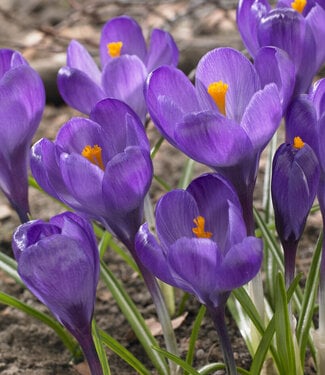Tulip (Latin name: tulipa) is originally from Kazakhstan. In the 16th century a part of Kazakhstan was conquered by the Ottoman Empire. The leader of the Ottoman Empire was Sultan Suleyman the First. The tulip was discovered in the mountains of Kazakhstan and they were very impressed with it’s beauty. Some tulips were brought to present-day Turkey and planted in the gardens of the most powerful people in the Ottoman Empire. Constantinople, now Istanbul, was in the 16th century one of the most beautiful cities in the world and important for its commerce and culture. The city had the most beautiful gardens where many people came to admire the flowers. Every year when the tulips were in bloom, a big party was given by the Sultan.
The tulip became very popular and was a symbol of power and wealth. To express this Ottoman sultans wore therefore a tulip on their turban. Because the tulip also seemed very much like the original turban is the tulip name derived from the Persian word 'tulipan' which means turban.
Sultan Suleyman the First gave some tulips to important guests, such as Ogier Ghiselin de Busbecq, the Viennese ambassador to the Ottoman Empire. In Austria de Busbecq gave his friend Carolus Clusius some tulips. Clusius managed at that time the gardens of the Emperor of Austria. In 1593 Clusius became a professor at Leiden University and head of the Hortus Botanicus Leiden. In this botanical garden the first tulips were planted in the Netherlands in 1593. The tulips were very scarce and therefore very expensive. Clusius didn’t want to sell or share his knowledge and just continue with his hobby. Unfortunately, some of his beautiful collection was subsequently stolen.
In the 17th century (1634-1637) the tulip craze (also known as tulip mania) burst. There was a lot of demand for tulips and they became more and more expensive. It is generally considered the first recorded speculative bubble. A single tulip bulb at one point had the value of an Amsterdam canalhouse. It could not continue to go well and in Februari 1637 the tulip craze stopped just as quickly as it had begun. A seller couldn't sell a batch of tulip bulbs that he had offered for 1,400 guilders. That week, trade in Holland and Utrecht came to a standstill. Some people became very rich but many speculators were destitute.
The first tulips had flamed flowers, as painted by famous Dutch painters of the 17th century. However, Rembrandt van Rijn never painted tulips. These flames were the result of a viral infection. Flamed tulips today, as Helmar and Rem's Favourite, are healthy tulips whose flame is genetic.
In many cities worldwide there are still tulip festivals organized during the flowering of this particular flower. For example, in Istanbul blooms every spring more than 10 million tulips. Also in Amsterdam you can admire lots of tulips during the Tulip Festival in April.
You can order the tulip bulbs of the contemporary Rembrandt tulips here: https://www.tulipstore.eu/en/tulips/rembrandt-tulips/





